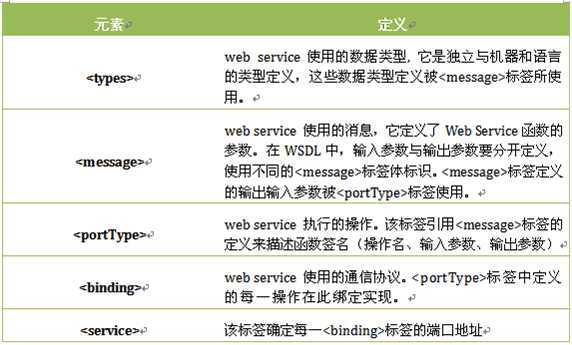标签:style blog http java color 使用
WSDL的主要文档元素

WSDL文档可以分为两部分。顶部分由抽象定义组成,而底部分则由具体描述组成。抽象部分以独立于平台和语言的方式定义SOAP消息,它们并不包含任何随 机器或语言而变的元素。这就定义了一系列服务,截然不同的应用都可以实现。具体部分,如数据的序列化则归入底部分,因为它包含具体的定义。在上述的文档元 素中,<types>、<message>、<portType>属于抽象定义 层,<binding>、<service>属于具体定义层。所有的抽象可以是单独存在于别的文件中,也可以从主文档中导入。
WSDL文档的结构实例解析
下面我们将通过一个实际的WSDL文档例子来详细说明各标签的作用及关系。
<?xml version="1.0" encoding="UTF-8"?> <definitions xmlns:soap="http://schemas.xmlsoap.org/wsdl/soap/" xmlns:tns="http://www.jsoso.com/wstest" xmlns:xsd="http://www.w3.org/2001/XMLSchema" xmlns="http://schemas.xmlsoap.org/wsdl/" targetNamespace="http://www.jsoso.com/wstest" name="Example"> <types> <xsd:schema> <xsd:import namespace="http://www.jsoso.com/wstest" schemaLocation="http://localhost:8080/hello?xsd=1"></xsd:import> </xsd:schema> </types> <message name="toSayHello"> <part name="userName" type="xsd:string"></part> </message> <message name="toSayHelloResponse"> <part name="returnWord" type="xsd:string"></part> </message> <message name="sayHello"> <part name="person" type="tns:person"></part> <part name="arg1" type="xsd:string"></part> </message> <message name="sayHelloResponse"> <part name="personList" type="tns:personArray"></part> </message> <message name="HelloException"> <part name="fault" element="tns:HelloException"></part> </message> <portType name="Example"> <operation name="toSayHello" parameterOrder="userName"> <input message="tns:toSayHello"></input> <output message="tns:toSayHelloResponse"></output> </operation> <operation name="sayHello" parameterOrder="person arg1"> <input message="tns:sayHello"></input> <output message="tns:sayHelloResponse"></output> <fault message="tns:HelloException" name="HelloException"></fault> </operation> </portType> <binding name="ExamplePortBinding" type="tns:Example"> <soap:binding transport="http://schemas.xmlsoap.org/soap/http" style="rpc"></soap:binding> <operation name="toSayHello"> <soap:operation soapAction="sayHello"></soap:operation> <input> <soap:body use="literal" namespace="http://www.jsoso.com/wstest"></soap:body> </input> <output> <soap:body use="literal" namespace="http://www.jsoso.com/wstest"></soap:body> </output> </operation> <operation name="sayHello"> <soap:operation soapAction="sayHello"></soap:operation> <input> <soap:body use="literal" namespace="http://www.jsoso.com/wstest"></soap:body> </input> <output> <soap:body use="literal" namespace="http://www.jsoso.com/wstest"></soap:body> </output> <fault name="HelloException"> <soap:fault name="HelloException" use="literal"></soap:fault> </fault> </operation> </binding> <service name="Example"> <port name="ExamplePort" binding="tns:ExamplePortBinding"> <soap:address location="http://localhost:8080/hello"></soap:address> </port> </service> </definitions>
由于上面的事例XML较长,我们将其逐段分解讲解
WSDL文档的根元素:<definitions>
<definitions xmlns:soap="http://schemas.xmlsoap.org/wsdl/soap/" xmlns:tns="http://www.jsoso.com/wstest" xmlns:xsd="http://www.w3.org/2001/XMLSchema" xmlns="http://schemas.xmlsoap.org/wsdl/" targetNamespace="http://www.jsoso.com/wstest" name="Example"> …… …… </definitions>
<definitions>定义了文档中用到的各个xml元素的namespace缩写,也界定了本文档自己的 targetNamespace="http://www.jsoso.com/wstest",这意味着其它的XML要引用当前XML中的元素时,要声 明这个namespace。注意xmlns:tns="http://www.jsoso.com/wstest"这个声明,它标示了使用tns这个前缀 指向自身的命名空间。
WSDL文档数据类型定义元素:<types>
<types> <xsd:schema> <xsd:import namespace="http://www.jsoso.com/wstest" schemaLocation="http://localhost:8080/hello?xsd=1"></xsd:import> </xsd:schema> </types>
<types>标签定义了当前的WSDL文档用到的数据类型。要说明的是,为了最大程度的平台中立性,WSDL 使用 XML Schema 语法来定义数据类型。这些数据类型用来定义web service方法的参数和返回值。对于通用的原生数据类型如:integer , boolean , char , float等,在W3C的标准文档http://www.w3.org/2001/XMLSchema中已经做了定义。这里我们要引入的schema定义 schemaLocation="http://localhost:8080/hello?xsd=1"是我们自定义的Java对象类型。
WSDL文档消息体定义元素:< message >
<message name="toSayHello"> <part name="userName" type="xsd:string"></part> </message> <message name="toSayHelloResponse"> <part name="returnWord" type="xsd:string"></part> </message> <message name="sayHello"> <part name="person" type="tns:person"></part> <part name="arg1" type="xsd:string"></part> </message> <message name="sayHelloResponse"> <part name="personList" type="tns:personArray"></part> </message> <message name="HelloException"> <part name="fault" element="tns:HelloException"></part> </message>
<message>元素定义了web service函数的参数。<message>元素中的每个<part>子元素都和某个参数相符。输入参数在<message>元素中定义,与输出参数相 隔离,输出参数有自己的<message>元素。兼作输入、输出的参数在输入输出的<message>元素中有它们相应的<part>元素。输出 <message>元素以"Response"结尾,对Java而言方法得返回值就对应一个输出的<message>。每个<part>元素都有名字和类 型属性,就像函数的参数有参数名和参数类型。
在上面的文档中有两个输入参数、两个输出参数和一个错误参数(对应Java中的Exception)。
? 输入参数<message>的name属性分别命名为toSayHello,sayHello。
toSayHello对应输入参数userName,参数类型为xsd:string,在Java语言中就是String;
sayHello对应两个输入参数person和arg1,类型为tns:person和xsd:string。这里tns:person类型就是引用了< types >标签中的类型定义。
? 输出参数<message>的name属性分别命名为toSayHelloResponse和sayHelloResponse。
这个名称和输入参数的<message>标签name属性对应,在其后面加上Response尾缀。
toSayHelloResponse对应的返回值是returnWord,参数类型为xsd:string;
sayHelloResponse对应的返回值是personList,参数类型为tns:personArray(自定义类型);
? 错误参数<message>的name属性为HelloException。
它的<part>子标签element而不是type来定义类型。
以上的message标签的name属性通常使用web
service函数方法名作为参照,错误参数标签则使用异常类名为参照。标签中的参数名称,即part子元素的name属性是可自定义的(下一章节详细说
明)。message标签的参数类型将引用types标签的定义。
WSDL文档函数体定义元素:< portType >
<portType name="Example"> <operation name="toSayHello" parameterOrder="userName"> <input message="tns:toSayHello"></input> <output message="tns:toSayHelloResponse"></output> </operation> <operation name="sayHello" parameterOrder="person arg1"> <input message="tns:sayHello"></input> <output message="tns:sayHelloResponse"></output> <fault message="tns:HelloException" name="HelloException"></fault> </operation> </portType>
在<operation>元素中,name属性表示服务方法名,parameterOrder属性表示方法的参数顺序,使用空格符分割多个参 数,如:“parameterOrder="person arg1”。<operation>元素的子标签<input>表示输入参数说明,它引用<message>标签中的输入参 数。<output>表示输出参数说明,它引用<message>标签中的输出参数。<fault>标签在Java方法中的特别 用来表示异常(其它语言有对应的错误处理机制),它引用<message>标签中的错误参数。
WSDL绑定实现定义元素:< binding >
<binding name="ExamplePortBinding" type="tns:Example"> <soap:binding transport="http://schemas.xmlsoap.org/soap/http" style="rpc"></soap:binding> <operation name="toSayHello"> <soap:operation soapAction="sayHello"></soap:operation> <input> <soap:body use="literal" namespace="http://www.jsoso.com/wstest"></soap:body> </input> <output> <soap:body use="literal" namespace="http://www.jsoso.com/wstest"></soap:body> </output> </operation> <operation name="sayHello"> <soap:operation soapAction="sayHello"></soap:operation> <input> <soap:body use="literal" namespace="http://www.jsoso.com/wstest"></soap:body> </input> <output> <soap:body use="literal" namespace="http://www.jsoso.com/wstest"></soap:body> </output> <fault name="HelloException"> <soap:fault name="HelloException" use="literal"></soap:fault> </fault> </operation> </binding>
<binding>标签是完整描述协议、序列化和编码的地方,<types>,<message>和<portType>标签处理抽象的数据内容,而<binding>标签是处理数据传输的物理实现。
<binding>标签把前三部分的抽象定义具体化。
首先<binding>标签使用<soap:binding>的transport和style属性定义了Web
Service的通讯协议HTTP和SOAP的请求风格RPC。其次<operation>子标签将portType中定义的
operation同SOAP的请求绑定,定义了操作名称soapAction,输出输入参数和异常的编码方式及命名空间。
WSDL服务地址绑定元素:< service >
<service name="Example"> <port name="ExamplePort" binding="tns:ExamplePortBinding"> <soap:address location="http://localhost:8080/hello"></soap:address> </port> </service>
service是一套<port>元素。在一一对应形式下,每个<port>元素都和一个location关联。如果同一个<binding>有多个<port>元素与之关联,可以使用额外的URL地址作为替换。
一个WSDL文档中可以有多个<service>元素,而且多个<service>元素十分有用,其中之一就是可以根据目标URL来组织端口。在一个
WSDL文档中,<service>的name属性用来区分不同的service。在同一个service中,不同端口,使用端口的"name"属性区
分。
简单的描述了WSDL对SOAP协议的支持,以及在Web Service中的作用。
标签:style blog http java color 使用
原文地址:http://www.cnblogs.com/syphper/p/3831810.html